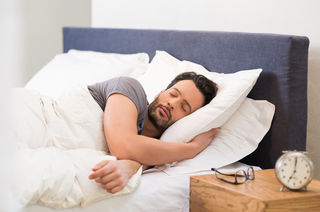ADHD
Can You Improve Adult ADHD Without Medications?
Adult ADHD and seven non-drug treatments.
Posted February 27, 2017 Reviewed by Kaja Perina

When I met Charles*, he was a 33-year-old married man who worked in the publishing industry. He had jumped from job to job. Sometimes he left a job due to boredom; other times he left because he felt overwhelmed. On occasion, his managers asked him to leave.
These work issues prompted Charle to contact me. In the past, Charles sought out treatment for depression and discontent. Antidepressants, anxiety medications, nor therapy helped.
Charles long suspected he had some type of learning problem. He was an average student, though he worked relentlessly on homework and class assignments. He seemed to spend two to three times longer than most of his classmates on tasks. This left Charles feeling discouraged and ashamed of his performance, and at times would go through episodes of depression. He just couldn’t understand why he couldn’t keep up with work or achieve his goals.
When I first met with Charles, I asked him if he daydreamed, was easily distracted, and chronically procrastinated. He was always late for school, classes, and carpooling. The other students teased him as a space cadet. He often forgot his homework or lunch, but his mother would rescue him. Charles’s father and first cousin had similar symptoms but were never diagnosed with ADHD.
After completing an in-depth psychiatric assessment at my office, I diagnosed Charles with Attention Deficit/Hyperactivity Disorder (ADHD), inattentive type. When we discussed the diagnosis of ADHD, Charles quickly connected all the dots of his life. It made complete sense. He felt a sense of relief; however a bit confused about what to do.
We discussed options for treatment, including medications and cognitive behavioral therapy (CBT). In addition, he was interested in trying therapy and using medications only as a “last resort.”
Charles’ request is quite common. Many people I treat for adult ADHD are interested in avoiding medications. To help Charles and people like him in my practice, I’ve outlined non-medication strategies to address adult ADHD.
1. Overcome Your Inner Critic with Cognitive Behavioral Therapy
We all have thousands of thoughts going through our minds that affect our feelings and behaviors. Some of the thoughts are positive, and some are negative or critical. Often, people with ADHD have excessively negative thoughts due to years of living with criticism and frustration. This loop of inner critical thoughts is called the "Inner Critic." Awareness and addressing this stream of thoughts can significantly improve your success. This is the basis of cognitive behavioral therapy.
Years of clinical research have consistently shown cognitive behavioral therapy (CBT) to be an effective treatment for various problems, including anxiety, panic attacks, phobias, depression, obsessive-compulsive disorder (OCD), and schizophrenia. Research has demonstrated the effectiveness of CBT for adult ADHD, with or without medication.1,2
CBT is a goal-directed therapeutic regimen focused on the interaction of thoughts, feelings, and behaviors to help patients feel better and flourish. Treatment occurs one on one, in couples, or in groups. However, many principles have been used in a self-help format to improve time management, productivity, and focus. If you are interested in CBT to address your ADHD, it is best to find a psychiatrist or therapist in your area who specializes in CBT. Also, see my article on Seven Ways to Overcome Procrastination.
2. Pay Attention

Paying attention is the problem with ADHD, right? Isn’t this treatment the same as saying, “just get better”? Well, not exactly. I am referring to a specific kind of paying attention: practicing mindfulness. Mindfulness describes a state of sustained attention to the present moment without judgment. This can be challenging to pay attention to all of life’s distractions, including the Internet, task lists, smart phones, and work responsibilities.
However, significant research shows that mindfulness can improve symptoms of ADHD, such as distractibility, attention, and sense of well-being.3,4 Many people with ADHD are initially intimidated by mindfulness or meditation because they have an image of a guru meditating for hours or think it must involve religion. This is not the case; however, many practices are as brief as five to ten minutes.
Mindfulness activities may include formal meditation practices such as t’ai chi, breathing exercises, or visualizations. They may also be informal, such as intentional focus during walking, eating, or brushing your teeth.
Start with five minutes of sitting down, just breathing with one of the recordings, and just notice what happens. Also, select a daily activity, such as eating breakfast, where you practice mindfulness and non-judging. Just be curious. You may be surprised.
3. Get Restful Sleep

People who have ADHD have an increased prevalence of sleep problems (insomnia) and chronic sleep deprivation, either trouble falling asleep, going to bed too late (night owl syndrome) or trouble waking up.5 Many researchers have found that people with ADHD have an increased risk for sleep disorders, including sleep apnea and a syndrome called delayed phases sleep disorder (“night owl syndrome”). Sleep deprivation can significantly impact many areas of a person’s life. Lack of quality sleep can worsen symptoms of ADHD including impulsivity and procrastination.6 A crucial part of management in adults with ADHD is to look for and aggressively treat sleep disorders. Non-drug treatments include evidenced-based cognitive behavioral therapy for insomnia (CBT-I), behavioral modifications, and improving sleep hygiene.
4. Improve Nutrition
The role of nutrition in the cause and treatment of ADHD is somewhat controversial. Research to support the many theories about dyes, additives, and sugar causing ADHD in children is unconvincing. That being said, many people with ADHD consume an unhealthy amount of high-carb and sugary foods while not getting enough fluids. Much of this is due to poor planning; adult ADHD patients are missing meals and filling in with unhealthy snacks. There is also a tendency to self-medicate with caffeine. Excess caffeine may cause exacerbate anxiety and distractibility.
I tell patients to take an inventory of what they are eating. Try to decrease sugar, caffeine, and carbohydrate intake gradually. Consider carrying pre-packaged, portion-controlled, and protein-rich snacks such as natural peanut butter, raw cheese sticks, or nuts.
5. Create Structure
Do you often feel overwhelmed, anxious, exhausted, and disorganized? People with ADHD often struggle with a cluster of cognitive skills called executive functioning. Executive functioning includes time management, initiating tasks, organization, prioritizing, and follow-through. One way to minimize this burden is to create more structure and order. Having a schedule or “game plan” helps patients feel calmer. Two effective strategies for increasing structure include utilizing a calendar and a task list. These tools help with planning and time management. Some people with ADHD have difficulty initially implementing these strategies, but once they are in place, both can be very beneficial (even therapeutic!)
6. Find an Activity Partner
An activity partner is having someone that you do a task with. Perhaps the best way to explain is to provide an example. One of my adult patients with ADHD, a designer, found a junior designer to be his activity partner. They discussed the goals for the day, checked in about progress for the week, and worked collaboratively on the project. His productivity greatly increased, but so did the creative output of the team. Plus, the work environment was a lot more enjoyable for everyone. This approach has been remarkably helpful for my patients.
7. Improve Brain Function

Easier said than done, right? Well, not necessarily. Brain-derived neurotrophic factor (BDNF) is critical in brain growth and development. It is essential for mental tasks, such as focus, attention, and mood. Many scientists believe that antidepressants and other medications work, at least in part, by increasing BDNF. There are different ways to increase BDNF levels besides antidepressants, however. Exercise, incredibly intense exercise, can increase BDNF levels. For example, 7 Dr. Russell Barkley, an ADHD expert, encourages exercise as a critical element in comprehensive treatment for ADHD.
Research shows that social interaction8, sunlight9, decreased sugar intake10, and green tea11 also increase the levels of BDNF. Therefore, even though these recommendations sound suitable for all of us, I believe more research is necessary before determining a direct link between these factors and improvement in ADHD.
The problem is that procrastination and motivation can prevent people with ADHD from getting to the gym. I tell my patients never to write “gym” on their calendars. It is too intimidating for the “procrastinating brain.” Write easy tasks such as “get on the bike for 10 minutes” or “walk for 15 minutes and listen to music.” I have found this increases the chances of my patients getting into exercise. Find a sport you enjoy or just start with a walk for ten minutes and be open to where this may go.
Charles’ experience with non-drug ADHD treatments
I treated Charles with weekly CBT for six months. We discussed five specific goals that he wanted to achieve:
• A job promotion
• Get in shape
• Improve his relationship with his wife
• Consistently leave work by 6 pm (rather than 9 pm)
• Get back in touch with his friends
At each session, we started with a specific agenda that focused on his goals, and he had homework between sessions that we discussed at the following session. As a big part of evidenced-based CBT, we explored his thoughts, anxieties, and fears that led to procrastination and other ADHD symptoms. I taught Charles a variation of traditional CBT that helped him identify and overcome his fears and get the wind back in his sails. He was happier and more energetic than ever.
I referred him to a sleep doctor who diagnosed him with delayed phase sleep disorder and started him on a low dose of melatonin (available over the counter). He started going to bed at 11 pm rather than 1 am and woke at 6 am. This early start in the morning allowed him to run for 20 minutes. He increased the amount of protein-rich foods at every meal and had small protein-filled snacks during the day. He could also reduce his caffeine intake, probably because of his better sleep and diet.
Charles’ administrative assistant became his activity partner at work. Charles met with him for two hours in the morning and created a collaborative atmosphere (previously, it had been a delegation-only relationship). Charles also started using a paper calendar for all of his tasks and deadlines, both work and professional. During my time with him, Charles’ income increased by 25%.
Charles’ wife became his activity partner at home. He had always avoided filing papers at home or paying the bills, which led to arguments with his wife about late fees and piles of paper. Now they spend one hour per week at the kitchen table going through all of the mail for the week, paying bills, and discussing any upcoming obligations. While this may seem like a miserable chore, it brought the two closer together and resolved an ongoing difficulty between them. Charles and his wife also began using an intentional dialogue exercise, a mindfulness practice often used in couple therapy. His relationship with his wife became stronger, and they are now discussing having a baby!
Adult ADHD can be challenging and stand in the way of your goals. There are treatments for adult ADHD, and not all require medication. So if you would like to learn more about Adult ADHD and coping strategies, please visit my website at www.scottshapiromd.com.
*Disclaimer: All details of individuals and events are fictional. Any resemblance to actual individuals or events is purely coincidental.
References
1. Safren SA, Sprich S, Mimiaga MJ, et al. Cognitive behavioral therapy vs relaxation with educational support for medication-treated adults with ADHD and persistent symptoms: a randomized controlled trial. JAMA. Aug 25 2010;304(8):875-880. doi:10.1001/jama.2010.1192
2. Mongia M, Hechtman L. Cognitive behavior therapy for adults with attention-deficit/hyperactivity disorder: a review of recent randomized controlled trials. Curr Psychiatry Rep. Oct 2012;14(5):561-567. doi:10.1007/s11920-012-0303-x
3. Bueno VF, Kozasa EH, da Silva MA, Alves TM, Louza MR, Pompeia S. Mindfulness Meditation Improves Mood, Quality of Life, and Attention in Adults with Attention Deficit Hyperactivity Disorder. Biomed Res Int. 2015;2015:962857. doi:10.1155/2015/962857
4. Gu Y, Xu G, Zhu Y. A Randomized Controlled Trial of Mindfulness-Based Cognitive Therapy for College Students With ADHD. J Atten Disord. Dec 01 2016:1087054716686183. doi:10.1177/1087054716686183
5. Yoon SY, Jain U, Shapiro C. Sleep in attention-deficit/hyperactivity disorder in children and adults: past, present, and future. Sleep Med Rev. Aug 2012;16(4):371-388. doi:10.1016/j.smrv.2011.07.001
6. Chiang HL, Gau SS, Ni HC, et al. Association between symptoms and subtypes of attention-deficit hyperactivity disorder and sleep problems/disorders. J Sleep Res. Dec 2010;19(4):535-545. doi:10.1111/j.1365-2869.2010.00832.x
7. Szuhany KL, Bugatti M, Otto MW. A meta-analytic review of the effects of exercise on brain-derived neurotrophic factor. Journal of psychiatric research. 2015;60:56-64. doi:10.1016/j.jpsychires.2014.10.003
8. Branchi I, D'Andrea I, Fiore M, Di Fausto V, Aloe L, Alleva E. Early social enrichment shapes social behavior and nerve growth factor and brain-derived neurotrophic factor levels in the adult mouse brain. Biol Psychiatry. Oct 01 2006;60(7):690-696. doi:10.1016/j.biopsych.2006.01.005
9. Molendijk ML, Haffmans JP, Bus BA, et al. Serum BDNF concentrations show strong seasonal variation and correlations with the amount of ambient sunlight. PLoS One. 2012;7(11):e48046. doi:10.1371/journal.pone.0048046
10. Araya AV, Orellana X, Espinoza J. Evaluation of the effect of caloric restriction on serum BDNF in overweight and obese subjects: preliminary evidences. Endocrine. Jun 2008;33(3):300-304. doi:10.1007/s12020-008-9090-x
11. Lardner AL. Neurobiological effects of the green tea constituent theanine and its potential role in the treatment of psychiatric and neurodegenerative disorders. Nutr Neurosci. Jul 2014;17(4):145-155. doi:10.1179/1476830513y.0000000079




